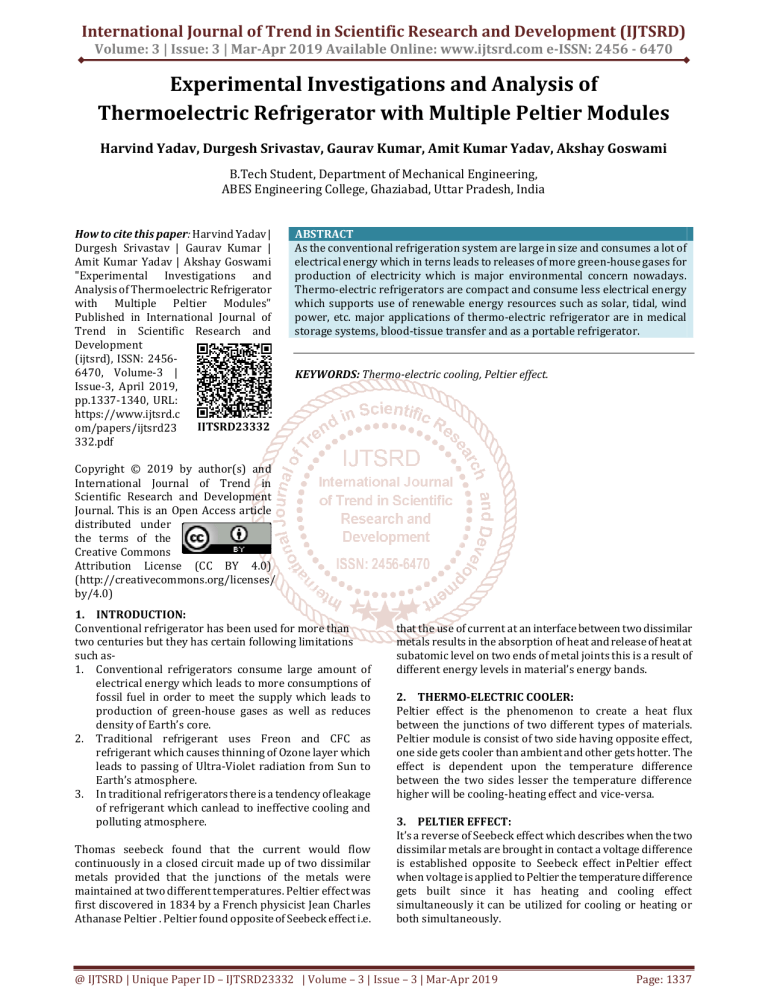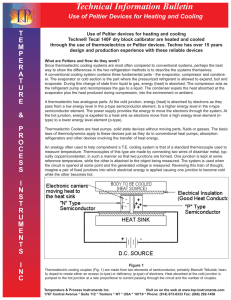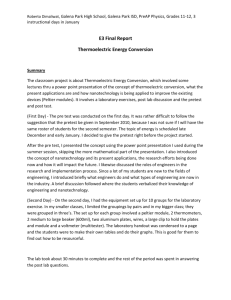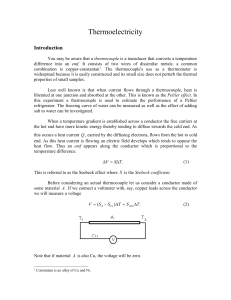
International Journal of Trend in Scientific Research and Development (IJTSRD)
Volume: 3 | Issue: 3 | Mar-Apr 2019 Available Online: www.ijtsrd.com e-ISSN: 2456 - 6470
Experimental Investigations and Analysis of
Thermoelectric Refrigerator with Multiple Peltier Modules
Harvind Yadav, Durgesh Srivastav, Gaurav Kumar, Amit Kumar Yadav, Akshay Goswami
B.Tech Student, Department of Mechanical Engineering,
ABES Engineering College, Ghaziabad, Uttar Pradesh, India
How to cite this paper: Harvind Yadav |
Durgesh Srivastav | Gaurav Kumar |
Amit Kumar Yadav | Akshay Goswami
"Experimental Investigations and
Analysis of Thermoelectric Refrigerator
with Multiple Peltier Modules"
Published in International Journal of
Trend in Scientific Research and
Development
(ijtsrd), ISSN: 24566470, Volume-3 |
Issue-3, April 2019,
pp.1337-1340, URL:
https://www.ijtsrd.c
IJTSRD23332
om/papers/ijtsrd23
332.pdf
ABSTRACT
As the conventional refrigeration system are large in size and consumes a lot of
electrical energy which in terns leads to releases of more green-house gases for
production of electricity which is major environmental concern nowadays.
Thermo-electric refrigerators are compact and consume less electrical energy
which supports use of renewable energy resources such as solar, tidal, wind
power, etc. major applications of thermo-electric refrigerator are in medical
storage systems, blood-tissue transfer and as a portable refrigerator.
KEYWORDS: Thermo-electric cooling, Peltier effect.
Copyright © 2019 by author(s) and
International Journal of Trend in
Scientific Research and Development
Journal. This is an Open Access article
distributed under
the terms of the
Creative Commons
Attribution License (CC BY 4.0)
(http://creativecommons.org/licenses/
by/4.0)
1. INTRODUCTION:
Conventional refrigerator has been used for more than
two centuries but they has certain following limitations
such as1. Conventional refrigerators consume large amount of
electrical energy which leads to more consumptions of
fossil fuel in order to meet the supply which leads to
production of green-house gases as well as reduces
density of Earth’s core.
2. Traditional refrigerant uses Freon and CFC as
refrigerant which causes thinning of Ozone layer which
leads to passing of Ultra-Violet radiation from Sun to
Earth’s atmosphere.
3. In traditional refrigerators there is a tendency of leakage
of refrigerant which canlead to ineffective cooling and
polluting atmosphere.
Thomas seebeck found that the current would flow
continuously in a closed circuit made up of two dissimilar
metals provided that the junctions of the metals were
maintained at two different temperatures. Peltier effect was
first discovered in 1834 by a French physicist Jean Charles
Athanase Peltier . Peltier found opposite of Seebeck effect i.e.
that the use of current at an interface between two dissimilar
metals results in the absorption of heat and release of heat at
subatomic level on two ends of metal joints this is a result of
different energy levels in material’s energy bands.
2. THERMO-ELECTRIC COOLER:
Peltier effect is the phenomenon to create a heat flux
between the junctions of two different types of materials.
Peltier module is consist of two side having opposite effect,
one side gets cooler than ambient and other gets hotter. The
effect is dependent upon the temperature difference
between the two sides lesser the temperature difference
higher will be cooling-heating effect and vice-versa.
3. PELTIER EFFECT:
It’s a reverse of Seebeck effect which describes when the two
dissimilar metals are brought in contact a voltage difference
is established opposite to Seebeck effect inPeltier effect
when voltage is applied to Peltier the temperature difference
gets built since it has heating and cooling effect
simultaneously it can be utilized for cooling or heating or
both simultaneously.
@ IJTSRD | Unique Paper ID – IJTSRD23332 | Volume – 3 | Issue – 3 | Mar-Apr 2019
Page: 1337
International Journal of Trend in Scientific Research and Development (IJTSRD) @ www.ijtsrd.com eISSN: 2456-6470
For measuring heat absorbed at cold side and heat rejected
on hot side the following equations have been usedHeat absorbed at cold side (RE)Qc = (α × I × Tc) − ((I2 × Rm) ÷ 2) − (Km(Th − Tc))
Heat rejected at hot sideQh = (α × I × Th) + ((I2 × Rm) ÷ 2) − (Km(Th − Tc))
Work inputW = Qh − Q c
6. COMPONENTS USED IN EXPERIMENTAL SETUP:
A. PELTIER MODULE:
The Peltier module used is TEC1-12706 as its operating
conditions are feasible and it has moderate resistance and
power input.
Fig. 1: Peltier Effect
4. WORKING PRINCIPLE:
Mainly in thermoelectric module a two dissimilar conductors
are semiconductors as they can be doped and hence high
carrier charge can be achieved commonly Bismuth telluride
is used. As in fig.1 if the module is in reverse bias then the
electron from P side will move towards N type
semiconductor which means electron will move to high
energy state thus absorbing heat from surrounding and on
the other hand electron from N type semiconductor will
move to positive terminal which will cause electron to jump
in lower energy state thus releasing heat in surrounding.
Fig. 2: Nomenclature of Peltier module
Multiple couples are connected electrically in series and
thermally in parallel the couples are separated from one
another by ceramic.
The performance of Peltier module is greatly affected by the
temperature difference between the two sides, to achieve
very low temperature on cold side the hot side must be as
cool as possible by means of heat sinks or other cooling
systems.
5. METHODOLOGY:
To conduct experiment Cold side of Peltier consisting fan for
fast cooling of chamber isfitted inside the chamber and hot
side Heat sink have exhaust to surrounding, for measuring
real time temperature of cold side a digital thermometer is
fitted inside the cooling chamber.
Abbreviations –
α = Seebeck coefficient
Km = Peltier electrical conductance
Rm = Peltier electrical resistance
QC = Heat absorbed at cold side of Peltier
Qh = Heat rejected at hot side of Peltier
Th = Initial temperature of cooling chamber
Tc = Final temperature of cooling chamber
Vmax=Peltier maximum voltage rating
Imax = Peltier maximum current rating
Equations for Peltier coefficientsߙ = ܸ݉ܽܶ ÷ ݔℎ
Rm = ((Th − ∆Tmax) × Vmax) ÷ (Th × Imax)
Km = ((Th − ∆Tmax)(Vmax × Imax)) ÷ (2∆Tmax × Th)
Fig. 3: Peltier module Specifications of TEC1-12706
Size 40x40x3.9 cubic mm,
Weight 27g
Imax 6.4Amp, Vmax 14.4V, Rm 1.98 Ohms Max temperature
difference 68
Qmax (initially) 63 Watts
B. SMPS (SWITCHED MODE POWER SUPPLY):
The electronic power supply integrated with the switching
regulator for converting AC supply into DC efficiently and
consistently with desired output, called as switched mode
power supply. It is used to achieve regulated DC output
voltage from unregulated AC input source.
Fig.4: Block diagram of SMPS
@ IJTSRD | Unique Paper ID - IJTSRD23332 | Volume – 3 | Issue – 3 | Mar-Apr 2019
Page: 1338
International Journal of Trend in Scientific Research and Development (IJTSRD) @ www.ijtsrd.com eISSN: 2456-6470
Fig. 5: SMPS
Specification of SMPSInput Voltage
: 100-270V AC
Output Voltage
: 12V DC
Output Current
: 10Amp
Power Factor
: 0.95
Frequency Range
: 47-67Hz
C. SUPPLY REGULATOR:
A supply regulator is device which is used in order to get
steady, reliable output supply.
Fig. 7: Heat sink
E. DIGITAL THERMOMETER:
Digital thermometers are fast, accurate and easily portable
they have permanent probe attached to it. The response time
depends upon the type of sensor used it can be
thermocouple type, resistance type, or thermistor type. We
have used PM 10 model digital thermometer.
It acts as supply check for Peltier in order to prevent any
overloading from abruption in supply and it also facilitates in
providing a range of output supply within the max rating
limit to perform experiments.
Fig. 8: Digital thermometer
7. EXPERIMENTAL SETUP:
Experimental setup is made of ply-wood (thermal
conductivity: 0.13W/m-K at 25 degrees Celsius) and for
insulation we have used the polystyrene foam (thermal
conductivity: 0.033W/m-K at STP).
Fig. 6: Supply convertor
SpecificationsOutput Voltage : 0.1-12V DC
Output Current : 0.1-5Amp
D. HEAT SINK:
It is an integral part of thermo-electric refrigerator which
necessary for two reasonsA. To remove the heat of hot side of Peltier to atmosphere.
B. To properly circulate the medium inside the cooling
chamber to ensure fast response within the cooling
chamber.
Fig. 9: Prototype (front view)
@ IJTSRD | Unique Paper ID - IJTSRD23332 | Volume – 3 | Issue – 3 | Mar-Apr 2019
Page: 1339
International Journal of Trend in Scientific Research and Development (IJTSRD) @ www.ijtsrd.com eISSN: 2456-6470
The prototype has two separate compartments, upper
chamber has two Peltier module and lower chamber has
three Peltier module.
Graph no.2: In lower chamber
Cooling spaceUpper chamber : 240x270x140cubic mm
Lower chamber : 240x270x330cubic mm
Graph 2: Temperature vs Time graph of lower
In above graph, Three Peltier shows the temperature drop
from 35 to 23 degrees Celsius over a time period of 10 min in
lower chamber (240x270x330 i.e. 21.38L).
This shows the power increases significantly with an
increase in no. of Peltiers module with heat sinks.
9. CONCLUSION AND FUTURE SCOPE:
The study of Thermo-electric refrigerator has been done
successfully and the drop in temperature of 10 and 12
degrees has been observed in upper and lower chambers
respectively in 10 minutes.
In context of its future scope, the performance of this scale
refrigerator can be improved significantly by using efficient
liquid cooling to lower the hot side temperature as low as
possible.
The hot side exhaust can also be used as a hot blower.
Fig. 10: Prototype (top view)
Peltier operating conditionsInput voltage : 6V DC
Input current : 3Amp DC
8. RESULTS AND DISCUSSION:
Graph between temperatures of cooling space versus time
has been shown belowGraph no. 1: In upper chamber
Graph 1: Temperature vs Time graph of upper
In above graph, Two Peltier shows the temperature drop
from 35 to 25 degrees Celsius over a time period of 10 min in
upper chamber (240x270x140 cubic mm i.e. 9.07L).
10. REFERENCES:
[1] Manoj Kumar Rawat, Himadr Chattopadhya & Subhasis
Neogi, Volume 3, Pages 362-367, 2013, “A review on
development of thermoelectric refrigeration and air
conditioning system: A novel potential green
refrigeration and air conditioning technology”,22502459.
[2] Sujit G, Antony Varghese, Ashish Achankunju, Renchi
George & Vishnu V, Volume 2, Pages 373-379, 2016,
“Design
and
fabrication of thermoelectric
refrigerator with thermosiphonsystem”,2395-3470.
[3] Dongare V.K,
Kinare R.V,
Parkar M.H
&Salunke R.P, Volume 5, Pages 2970-2974, 2018,
“Design and
development
of thermoelectric
refrigerator”, e-2395-0056,p-2395-0072.
[4] Prof.
Rajendra.
P.
Patil, Pradhyumna
Suryawanshi, Akshay Pawar & Avdhoot Pawar, Pages
614-618, 2017, “Thermoelectricrefrigeration using
Peltier effect”, 2277-9655.
[5] Rakesh B.K., Anuj Shayam, Mithun Sharma. M.N.,
Mohan. M. & Vinay Karthik, Volume 1, Pages332338“Study, Analysisand Fabrication of thermoelectric
cooling system”, 2455-2631.
[6] Benziger B, Anu nair P & Balakrishnan P, Volume 4,
Pages 49-56 2015, “Review paper onthermoelectricairconditionerusing Peltiermodules”, 2319-2259.
[7] Thakkar Mohit Pravinchandra, “A report onPeltier
cooling module”.
[8] Pooja Iyer Mani, “A thesis on Design,Modeling and
simulation of a thermoelectric cooling system (TEC)”.
@ IJTSRD | Unique Paper ID - IJTSRD23332 | Volume – 3 | Issue – 3 | Mar-Apr 2019
Page: 1340







